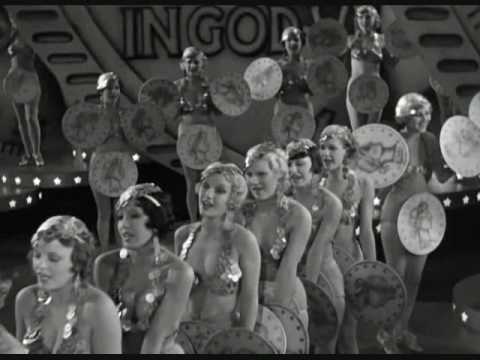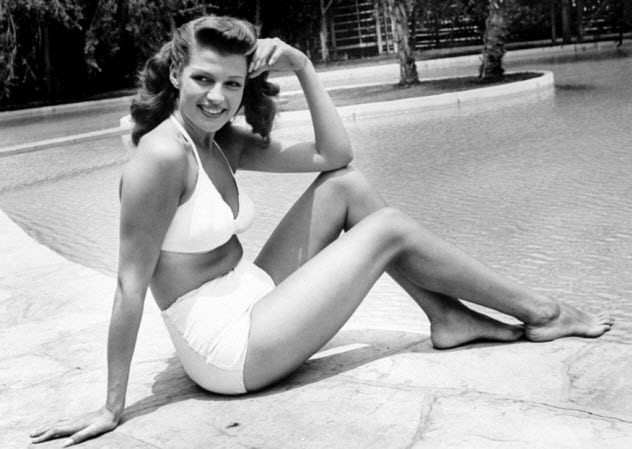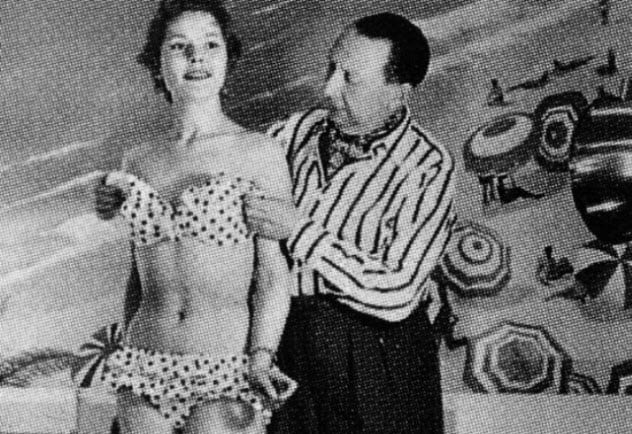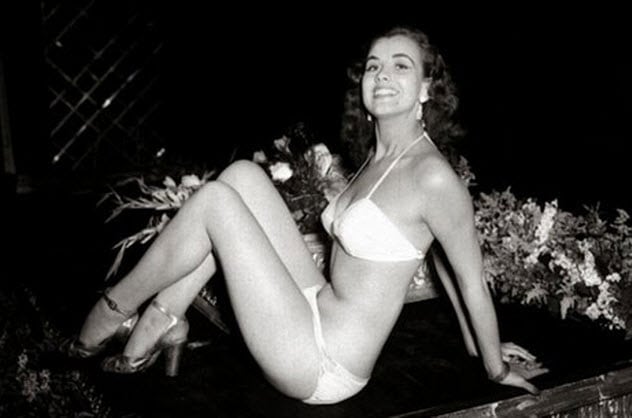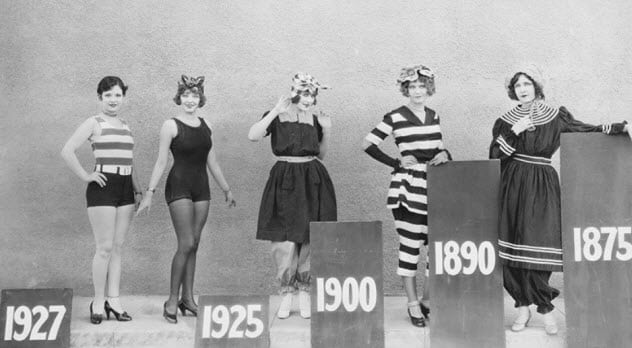Not only can the origins of this thoroughly modern outfit be traced back much further than we might expect, the road to its current status was a long and bumpy one. This list details some of the obscure facts about the bikini’s creation and development.
10 They Were Wearing Them In Ancient Times
The bikini is commonly considered to have been invented in France shortly after the end of World War II. But we have clear evidence that bikini-like costumes existed long before this. All the way back in 5600 BC, artists in the ancient settlement called Catalhoyuk—which was located in the southern part of Anatolia—were producing work that showed their goddess wearing an outfit that looks like a bikini. Furthermore, paintings and urns dating back to ancient Greece in 1400 BC clearly show women dressed in two-piece outfits that are a forerunner of the bikinis worn today. They were taking part in sporting or athletic activities. A prototype of the bikini was also a feature of ancient Rome. Sicily’s Villa Romana del Casale contains a mosaic artwork called “Coronation of the Winner” that shows women in costumes that are almost identical to the bikini of today. These women were playing handball, running, and throwing the discus.[1]
9 They Were Featured In Ancient Literature As Well
Visual examples are not the only evidence that the bikini or similar items of clothing go back a long way. There are also a number of references to such garments throughout ancient literature. Ovid, one of the three major Latin poets, writes about the potential for a woman to conceal love letters inside a top that he describes as looking like a strip of cloth worn around the chest area. That certainly sounds a lot like a bikini top. Martial, a second Latin poet who came from Hispania and lived between AD 86 and AD 103, wrote a satirical piece of poetry about a rather butch female athlete. He describes her as eating, drinking, vomiting, and possibly having sex with other women while wearing an outfit that clearly mirrors what we would consider a bikini. Another piece by Martial includes a mention of a prostitute called Chione wearing a bikini to a bathhouse.[2] Ironically, given how risque the costume was considered when it was introduced during the 1940s, it is portrayed in this satire as being an example of an immodest woman trying to conceal her true nature—as most women would have been naked when visiting the bathhouse and a prostitute would frequently be naked in front of others.
8 They Were Previewed On The Silver Screen
Most people know that movie stars helped to popularize the bikini. The French actress and sex symbol Brigitte Bardot was famously photographed in one during the 1953 Cannes Film Festival, which caused sales of the swimsuit to skyrocket almost immediately in France. Fewer people know that clothing almost identical to the modern bikini had appeared on the actual screen two decades earlier in a number of movies made during the legendary 1930s Hollywood era. This was before the National Legion of Decency’s production code (and strict adherence to the Hays Code) came into force. The great Busby Berkeley musical Gold Diggers of 1933 features dancers wearing bikini-style, two-piece swimsuits made of coins,[3] while chorus girls are in skimpy, two-piece bathing outfits in the following year’s Fashions of 1934. Pre-Code Hollywood is often celebrated for its daring and progressiveness, and this is another example of it being far ahead of its time.
7 The War Helped Bring Them About
The bikini as we know it today did not achieve mainstream acceptance in the US until the 1960s. But the process was kick-started 20 years earlier when more modest two-piece swimsuits hit beaches in America with a little help from World War II. With the US at war in 1942 and needing uniforms for the 16 million men and women who were fighting for their country, the nation’s War Production Board forced civilian clothing manufacturers to reduce the amount of fabric they used. The actual regulation with such an impact on our culture was L-85.[4] It did not only apply to those who made swimwear, but it did lead those manufacturers to come up with a smart solution to the problem. They devised two-piece costumes as a way of complying with L-85. The exposed midriff meant less fabric was needed. The following year, further fabric rationing saw women’s swimsuits become even briefer. By this time, two-piece swimsuits were common in publicity photos of Hollywood actresses like Rita Hayworth and Ava Gardner. This made women more comfortable with them.
6 The Name Has Dark Associations
The man who is credited with the creation of the bikini is Louis Reard, an engineer from France, with the grand launch of his invention taking place on July 5, 1946. This period just after World War II was when the atomic bomb was undergoing testing by US scientists. The chosen site for a lot of these deadly tests was the Bikini Atoll in the Marshall Islands. Reard’s unveiling of his controversially skimpy new bathing suit took place just days after one of these deadly bomb tests. Clearly, the issue was on his mind as he chose to name his garment after the test location.[5] The inspiration for the design was Reard witnessing Saint-Tropez sunbathers trying to increase their tanning areas by rolling up parts of their swimsuits. But the name he chose suggests that he was not oblivious to events in the wider world. To be fair to Reard, the launch of the bikini created shock waves around the globe, so maybe it wasn’t such an odd choice.
5 Reard Had A Rival
While Reard claimed a place in the history books, it could have been a lot different as there was another man during the same period who had similar ideas. Jacques Heim was a fashion designer from France who ran a shop in Cannes that sold swimwear. In May 1946, two whole months before Reard launched his creation, Heim debuted a new two-piece swimming costume. He gave it the name Atome, which means “atom” in French. He emphasized its skimpiness by comparing it to the tiniest known particle of matter. Given that he got there first, why didn’t Heim go down in history as the man who came up with the bikini? He brought in skywriters to advertise his creation as the smallest female bathing suit ever, only for Reard to do the same a few weeks later. By wittily stating that it had “split the Atome,” Reard’s ad pointed out that his creation was even scantier than his rival’s.[6] Ultimately, Reard was the man who took the plaudits due to a combination of his more radical, eye-catching design and his chosen name, Bikini, resonating with the public in a way that Atome did not.
4 Resistance To Them Was Fierce
The bikini attracted a fierce backlash when it first appeared. The design was considered so scandalous that no professional model was prepared to wear one for its official launch. Reard had to pay 19-year-old Micheline Bernardini, who worked as a nude dancer at the Casino de Paris, to model it.[7] The press conference also produced outrage from the journalists who were present due to the exposure of Bernardini’s belly button. In fact, the bikini was instantly banned in a number of places, including France, Italy, and Spain. The swimsuit was also greeted with disapproval in the US. An attempt was made to bring it into the mainstream through the Miss World competition of 1951. But when winner Kiki Hakansson of Sweden received her prize wearing a bikini, religious groups caused such a fuss that the organizers of Miss World and other beauty pageants banned the costume.
3 They Were A Lot More Practical Than Some Of Their Precursors
The advent of the bikini must have come as a great relief to many women considering the impractical things they had to wear on the beach in earlier eras. During the 19th and early 20th centuries, there was a strong emphasis on female modesty when swimming. Women had to wear full-body costumes—complete with stockings—that were made of materials like wool or flannel. Aside from being extremely uncomfortable in hot weather, these garments were unsuitable for actual bathing because the wool retained water. As soon as a woman spent any time swimming, the suit would become heavy, shapeless, and baggy. Drying it was also incredibly difficult.[8] The bikini represented the endpoint of a move toward focusing on practicality when creating swimwear for women. That movement was started by Australian professional swimmer Annette Kellerman who had previously endured a 1907 arrest at a Massachusetts beach for wearing a formfitting, one-piece costume with bare legs.
2 There Are Lots Of Different Types Of Bikini These Days
It took a long time for this type of swimsuit to become socially acceptable. But once it happened, the bikini went on to spawn multiple variants of the original. One of the first was the string bikini. It is believed to have been unintentionally created by Rose de Primallio, a fashion model from Brazil, after she was left with a minimal amount of fabric to make an outfit for a shoot. However, PR man Glen Tororich and his model wife, Brandi Perret-DuJon, officially launched this swimsuit at the grand opening of a shopping mall in New Orleans during 1974. The monokini, which was created in the mid-1960s by Rudi Gernreich, was initially a swimsuit with a tight bottom half and two thin strings that left a woman’s breasts exposed. (Other versions have been created as well.) For obvious reasons, this has remained a more niche variant, just as with Gernreich’s obscure pubikini. Another version that reduces the material is the microkini, which pushes exposure to the absolute limit permitted in most countries. The tankini, which first appeared in the late 1990s, works on the principle of concealing more by combining bikini bottoms with a tank top. Meanwhile, the skirtini reverses this by featuring standard bikini tops and skirt bottoms. Finally, the controversial burkini covers the entire body and was specifically designed by Australian Aheda Zanetti for Muslim women to wear at the beach.[9] This outfit was banned in various parts of France during 2016, although the ban was overturned on appeal.
1 But You Couldn’t Afford The Most Expensive One
While the swimsuits just discussed could be worn by anyone bold enough, some bikinis are definitely beyond the financial reach of ordinary people. One example created in 1977 was made of platinum, cost nearly $10,000, and was worn by Miss United Kingdom at that year’s Miss World Contest. At the time, it was the most expensive bikini ever made. In 2006, it was overtaken by a creation from fashion designer Susan Rosen that cost a staggering $30 million and was made entirely of flawless 150-carat diamonds. This sounds as uncomfortable to wear as it would be unaffordable for most.[10] However, there is always the “bling-kini.” Made by fashion design firm Pistol Panties in 2009, the bling-kini has a covering of 5,000 Swarovski crystals and would only set the buyer back £2,000. I am a freelance writer who has written jokes and sketches for BBC radio comedy shows. I have also written and directed short films as part of the groups Ensemble and Wardlaw Films.


